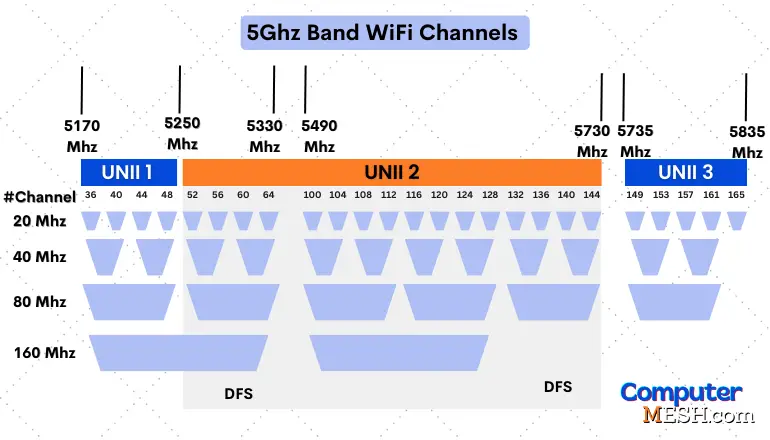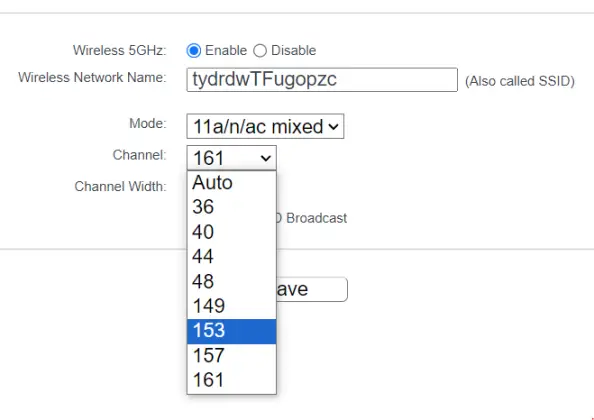Guide to 5GHz WiFi & How to Choose Best Channel for 5Ghz?
WiFi speed and availability are essential for each of us today. What if you have the best WiFi connection, good router, and active 5GHz WiFi band yet have problems with internet speed and network?
You might think you have got all of it right, but there is something you should check – the Best Channel for 5GHz WiFi to get the problem solved. Whether you are clueless about WiFi channels or want to know which channel is the best, you have reached the right place.
Here is a detailed guide on 5GHz WiFi and selecting the best WiFi channel to enjoy maximum benefits.
5Ghz Band WiFi & its Channels
Overview of 5GHz WiFi
The 5GHz WiFi was introduced way back in 1997. But it picked up pace about 15 years ago and has been the major band used ever since. Another important WiFi band is 2.4GHz, which was found much earlier. 5GHz has better channels and provides improved speed.
Like I said earlier, even if you have done everything right but have chosen the wrong channel, like one that is too busy, higher ping and congested or one that also has interference, your internet speed is going to be down. That’s precisely why you should focus on selecting the right channel.
But before that, what exactly a WiFi Channel is?
Understanding WiFi Channels
Let’s just say there are WiFi frequency bands that help in sending out information using the internet. The most popular WiFi bands are 5 GHz and 2.4 GHz. Now, each of these bands has several smaller slots/bands. These smaller bands within the WiFi frequency bands are WiFi channels.
A WiFi Channel can be best defined as the specific frequency range at which the router sends out information to a device. Each device that uses the WiFi network will use a single channel at a time. There are several WiFi channels available based on the WiFi frequency band you have
Advantages of 5GHz WiFi over 2.4Ghz
The internet era, as we can call it today, demands you not just to be available online but to be on your fingers. Whether you want to watch a video, attend a class, or play a game, you have got to be quick, and so does your internet speed. Initially, 2.4GHz WiFi was the most commonly used band. However, 5 GHz bands have become the trend over the past 15 years, especially recently.
• Faster data rates
If you are wondering what exactly is the difference between the two and what is more advantageous, you must look closely at the titles.
Basically, the higher the gigahertz (GHz), the more frequency you get. So, if you use a 2.4 GHz WiFi band with the best router, you can get a maximum speed of 600 Mbps.
In the case of a 5GHz WiFi band, you can get double the internet speed, of a maximum of up to 1300 Mbps. This is the essential difference between the two bands.
• Less interference from other devices and Wider channels for data transmission
With the 2.4 GHz network, there are only three-four available channels. However, the 5 GHz network has over 25 predefined channels. Most channels in the latter are also non-overlapping, meaning less interference.
Note: Even though ethernet doesn’t effect WiFi but it has capability to draw high speed rates than wireless connection.
Available Channels in the 5GHz Band (List)

The 5GHz band is categorized into four divisions with at least four channels. They are,
- U-NII 1 – 36, 40, 44, 48
- U-NII 2a – 52, 56, 60, 64
- U-NII 2c – 100, 104, 108, 112, 116, 120, 124, 128, 132, 126, 140, 144
- U-NII 3 – 149, 153, 157, 161, 165
The UNII – 1 is commonly used for general domestic use and can be accessed anytime. It is the popular one among the users, which means that they are best used at home, but there can also be some congestion. However, the congestion can easily be avoided by keeping unused devices disconnected and changing the common default password.
Regulatory restrictions affecting channel availability
There aren’t many restrictions that would hamper the availability of channels in U-NII – 1 – It is free and accessible to all of them.
But you might face certain restrictions or need additional things when you opt for other channels.
For example, your device must be equipped with Transmit Power Control (TPC) and Dynamic Frequency Selection (DFS) for the other UNIIs to ensure security and non-interference with weather stations and military devices.
This is because:
These certification requirements may vary from country to country, depending on their laws.
3 Factors to Consider When Choosing a 5GHz Channel
1. Interference from neighboring networks
When there is channel traffic, it is more likely you have interference from neighboring networks. But you can try to find a channel with weak interference in the UNII – 1 range to enjoy the best possible outcome. Many environmental factors and physical obstructions can also cause interference, so knowing what best fits your location is essential.
2. Channel width (20 MHz, 40 MHz, 80 MHz, 160 MHz)
Channel width is the signal width available to transfer data. The wider the channel width, the faster the internet speed. The main ones are 20 MHz, 40 MHz, 80 MHz and 160 MHz.
Even though 20 MHz has more non-overlapping channels, which helps you with less interference, 40 MHz and 80 MHz can provide maximum speed and are often recommended for domestic setups. 160 MHz can be your last resource if there is no other network interference.
Tip: In general, it is good to choose channels under UNII – 1, while opting for wider channel widths like 40 MHz or 80 MHz, which can help you have non-overlapping networks with minimal interference and maximum speed.
But in any of these cases, if you want to maximize the speed, you have to keep your device closer to your router.
3. Regulatory and regional restrictions
You have to consider your location before choosing a 5GHz channel.
It helps you know the laws and regulations regarding the use of the channels in your place. In most countries, the UNII – 1 channels are most recommended, but some places also allow you to use UNII – 2 and UNII – 3 with certain restrictions.
For instance, in the US, you need Dynamic Frequency Selection (DFS) if you opt for UNII – 2 or UNII – 2E channels.
In the below you can see the UNII – 3 channels (149, 153, 157, 161) are available for 5 Ghz band, it means it permissible use in the region, but it’s need to confirm that you are within compliance with local regulations and not causing interference with other services or systems, which may also use frequencies in the UNII-3 range.

Here on 5GHz, choosing the higher channel number the lower the interference you will face and better speed.
If you have specific questions about channel usage and regulatory compliance, you can reach out to your Internet Service Provider (ISP).
Tools and Techniques for Identifying the Best Channel
1. WiFi Analyzing: Whether you want to check for channel interference or need tools to identify the Best Channel for 5Ghz WiFi, you must approach a WiFi analyzer to analyze and find the optimal channel.
You can deploy an analyzer like an app on a smartphone to get data of channels in your place by scanning and choose accordingly. But if you want to interpret signal strength manually, you can sit and switch between WiFi channels manually and observe their performances to get the data.
2. Auto Selection: In many modern routers, you have the option of Automatic Channel Selection (ACS). This is an advanced feature that helps in identifying the best channel for 5Ghz available at a particular point.
ACS easily detects channels with the lowest interference and also double-checks them for optimal use ensuring maximum downloading rates and good upload speeds.
Overlapping channels and co-channel interference
The chances of overlapping channels are lesser in the 5GHz band, especially when you opt for UNII – 1. These channels do not overlap and so do not have much interference. But you have also got to use Channel width of either 20 MHz or 40 MHz to avoid the overlapping and co-channel interference because 160 MHz has only one non-overlapping channel.
While you can enjoy good speed and less congestion by opting for a proper WiFi Channel, you might sometimes also have difficulties because of other reasons.
Solutions for reducing interference and improving signal strength:
- Opt for a channel with less traffic.
- Keep the WiFi switched off in other devices when not in use.
- Keep your current devices and wireless hardware near the router.
- Consult with a network analyzer.
Finally, the Best Channel for 5Ghz WiFi varies based on your location and other details, but you can always opt for channels in UNII – 1 and use them 40 MHz or 80 MHz to enjoy gaming, transferring data or surfing with high speed internet.
